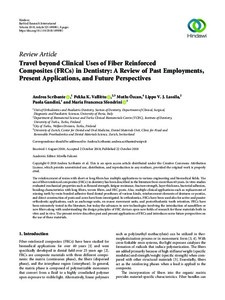Travel beyond Clinical Uses of Fiber Reinforced Composites (FRCs) in Dentistry: A Review of Past Employments, Present Applications, and Future Perspectives
Andrea Scribante; Pekka K. Vallittu; Mutlu Özcan; Lippo V. J. Lassila; Paola Gandini; Maria Francesca Sfondrini
Travel beyond Clinical Uses of Fiber Reinforced Composites (FRCs) in Dentistry: A Review of Past Employments, Present Applications, and Future Perspectives
Andrea Scribante
Pekka K. Vallittu
Mutlu Özcan
Lippo V. J. Lassila
Paola Gandini
Maria Francesca Sfondrini
HINDAWI LTD
Julkaisun pysyvä osoite on:
https://urn.fi/URN:NBN:fi-fe2021042720439
https://urn.fi/URN:NBN:fi-fe2021042720439
Tiivistelmä
The reinforcement of resins with short or long fibers has multiple applications in various engineering and biomedical fields. The use of fiber reinforced composites (FRCs) in dentistry has been described in the literature from more than 40 years. In vitro studies evaluated mechanical properties such as flexural strength, fatigue resistance, fracture strength, layer thickness, bacterial adhesion, bonding characteristics with long fibers, woven fibers, and FRC posts. Also, multiple clinical applications such as replacement of missing teeth by resin-bonded adhesive fixed dental prostheses of various kinds, reinforcement elements of dentures or pontics, and direct construction of posts and cores have been investigated. In orthodontics, FRCs have been used also for active and passive orthodontic applications, such as anchorage units, en-masse movement units, and postorthodontic tooth retention. FRCs have been extensively tested in the literature, but today the advances in new technologies involving the introduction of nanofillers or new fibers along with understanding the design principles of FRC devices open new fields of research for these materials both in vitro and in vivo. The present review describes past and present applications of FRCs and introduces some future perspectives on the use of these materials.
Kokoelmat
- Rinnakkaistallenteet [27094]
